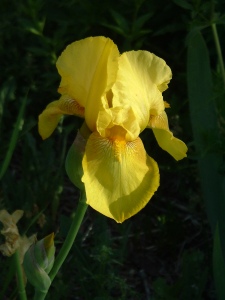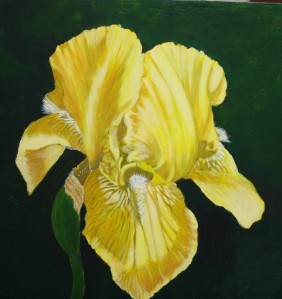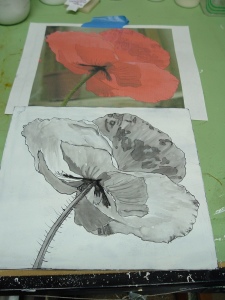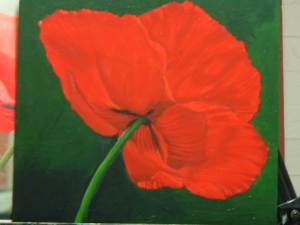Here is another painting I have been working on this week. This is 8.5×9.5 inch masonite panel. I am using Chroma’s Interactive acrylics. This is an acrylic paint that while it dries as fast as normal acrylics, I can rewet it and blend it even after it is touch dry. This means I can do some things similar to an oil painter. From a yellow Iris that grows in my garden.
 The reference photo; my granny grew these iris at her house on Gorden street and I brought some of them here.
The reference photo; my granny grew these iris at her house on Gorden street and I brought some of them here.
 Here is the ink drawing
Here is the ink drawing
 Then I toned the board with raw sienna and painted in the darks with burnt umber
Then I toned the board with raw sienna and painted in the darks with burnt umber
 then I begin the grey layers. The grey layers help me get the colors right later.
then I begin the grey layers. The grey layers help me get the colors right later.
 Here the grey layers are complete. You can still see a little of the raw sienna and even the ink drawing peeping through here. This is called the Flemish method, developed by the great master painters of the Renaissance. You can learn more about this method and see it done in oil by Delmus Phelps at: http://www.easy-oil-painting-techniques.org/
Here the grey layers are complete. You can still see a little of the raw sienna and even the ink drawing peeping through here. This is called the Flemish method, developed by the great master painters of the Renaissance. You can learn more about this method and see it done in oil by Delmus Phelps at: http://www.easy-oil-painting-techniques.org/
 Here I have just gone over the shadows with yellow ochre, see how the underpainting changes the colors of the layer on top giving a range of shades darker and lighter. This is not a physical mixing. Since this is an acrylic that can be rewet and worked longer I seal the under painting with a clear coat so there is no physical mixing with the color layers; just optical mixing.
Here I have just gone over the shadows with yellow ochre, see how the underpainting changes the colors of the layer on top giving a range of shades darker and lighter. This is not a physical mixing. Since this is an acrylic that can be rewet and worked longer I seal the under painting with a clear coat so there is no physical mixing with the color layers; just optical mixing.
 Now I have added Naple’s Yellow to most of the lighter areas.
Now I have added Naple’s Yellow to most of the lighter areas.
 I have now done several more color layers, working back and forth with yellow ochre, Naple’s yellow, and Indian yellow, glazing each one in thin layers. Note how much the underpainting still affects the color layers.
I have now done several more color layers, working back and forth with yellow ochre, Naple’s yellow, and Indian yellow, glazing each one in thin layers. Note how much the underpainting still affects the color layers.
 more color layers, still working back and forth between the three yellows
more color layers, still working back and forth between the three yellows
 Now, nearly finished, I’ve made some minor adjustments, like the beard on the center petal throws a cast shadow, which I’ve darkened a little to help the beard stand out more. (the beard is the fuzzy part on the petal, it’s actually the stamens, full of pollen)
Now, nearly finished, I’ve made some minor adjustments, like the beard on the center petal throws a cast shadow, which I’ve darkened a little to help the beard stand out more. (the beard is the fuzzy part on the petal, it’s actually the stamens, full of pollen)
I’ll be working on this a bit more today, adding some small highlights and such, but it’s about done.





























 As predicted, once the weather began to cool off those 11 foot tall Lima beans began setting pods.
As predicted, once the weather began to cool off those 11 foot tall Lima beans began setting pods. Hopi Purple Pod beans, a Native American variety, have set thick clusters of pods. I love this bean because it sets bunches of pods, I can fill the bowl in a few minutes, picking fistfuls of beans at a time. Picked really tiny you _can_ eat them as green beans, but they are at their best as green or dried shelled beans. They look a little like red pinto beans and have a full bodied meaty bean taste.
Hopi Purple Pod beans, a Native American variety, have set thick clusters of pods. I love this bean because it sets bunches of pods, I can fill the bowl in a few minutes, picking fistfuls of beans at a time. Picked really tiny you _can_ eat them as green beans, but they are at their best as green or dried shelled beans. They look a little like red pinto beans and have a full bodied meaty bean taste.



